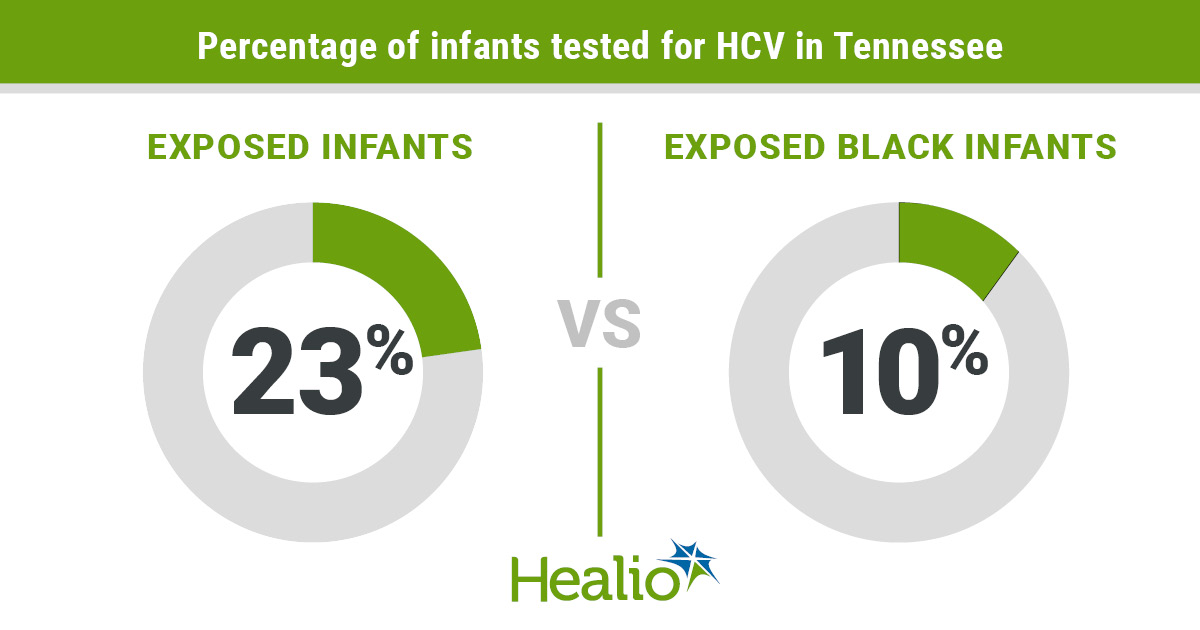In Tennessee, just 23% of at-risk infants are tested for HCV
Click Here to Manage Email Alerts

In Tennessee, only 23% of infants who were exposed to hepatitis C virus were tested for it, including just one in 10 black infants, study results suggested.
Stephen Patrick, MD, MPH, MS, director of the Center for Child Health Policy at Vanderbilt University School of Medicine, and colleagues enrolled 4,072 infants born to mothers aged 15 to 44 years from 2005 through 2014 who were enrolled in TennCare, Tennessee’s Medicaid program, and were perinatally exposed to HCV during the first 24 months. They compared outcomes with those of infants born to uninfected mothers (n =380,765).
Mothers who were HCV-positive compared with those who were HCV negative were more likely to be white (92.9%) than black (6.4%), more likely to have a higher gravidity, more likely to use tobacco and more likely to be HIV positive.
The researchers noted that Tennessee is “disproportionately affected by the rise of HCV among women with live births.”

“Physicians should be aware that hepatitis C infections among pregnant women are rising, and exposed infants are seldom tested for seroconversion,” Patrick told Healio. “Primary care physicians caring for infants should be aware that hepatitis C-exposed infants should be tested within the first 2 years of life. In addition, because testing for hepatitis C virus in pregnancy is not universal, providers caring for infants should be aware of risk factors that are associated of hepatitis C infection, including opioid exposure.”
The prevalence of infants exposed to HCV rose each year of the study, from 5.1 to 22.7 per 1,000 live births, the researchers reported. Vertical transmission is estimated to occur around 3% to 6% of the time. If the mother is coinfected with HIV, that rate can rise to 11%, according to the study.
“We have to test all exposed infants to ensure we do not miss any,” Patrick said. “For infants who go undetected and acquire the virus, they can go on to develop liver failure as they grow.”
Adequate testing was completed on 18% (n = 733) of infants exposed to HCV and was more likely to occur with several covariates, including white race; urban residence; maternal tobacco use; maternal HIV coinfection; lower birth weight; small for gestational age; NICU admission; and more well-child checks.
Of the exposed infants, just 946 (23%) were tested in the first 24 months.
“We found substantial differences in testing by race,” Patrick said. “Even after accounting for a multitude of individual and health system factors, we found that African American infants were nearly 70% less likely than white infants to be tested for the virus, — suggesting this finding is the result of systemic racial bias.”
Patrick said that the rise in HCV infections can be linked to the rising opioid epidemic occurring throughout the country.
“Bottom line, we need to do a better job,” he said. “The opioid crisis continues to affect a wide array of the U.S. population, including pregnant women and infants. Increasingly we are seeing complications from this rise ranging from hepatitis C infections in pregnant women to straining of our child welfare system. There is an urgent need for a comprehensive, well-funded approach to improving outcomes for pregnant women and infants affected by the opioid crisis.”
The researchers said that improving provider and patient education strategies would improve the care of those affected by or exposed to HCV. – by Ken Downey Jr.
Disclosures: The authors report no relevant financial disclosures.
